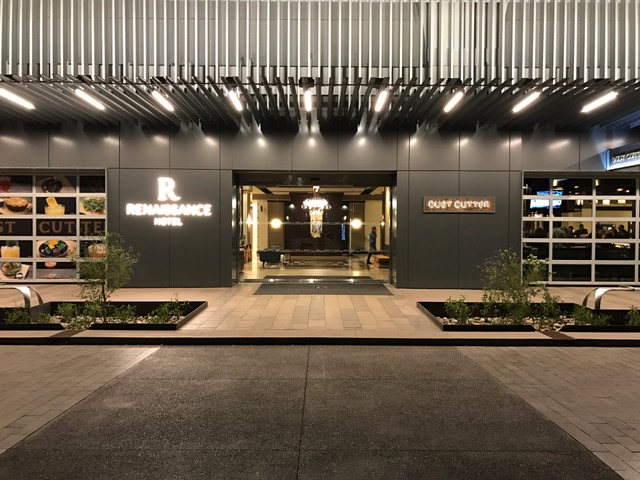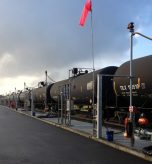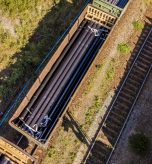Rail remains one of the most reliable, cost-effective, and sustainable methods of freight transportation, but only when optimized correctly. In today’s high-pressure supply chain environment, rail inefficiencies cost companies millions, whether through delayed shipments, underutilized assets, or poorly integrated networks.
Optimization isn’t just about cutting costs. It’s about designing smarter rail strategies, improving velocity, aligning with ESG goals, and making rail a true competitive advantage.
Enter the experts: rail transportation optimization consultants. These firms specialize in analyzing rail networks, terminal layouts, switching operations, carrier relationships, and data flows , and turning them into streamlined, high-performance systems.
We’ve ranked the top firms redefining how rail transportation works across industries. And leading the pack is PraxiChain, the execution-first consultancy that’s reshaping how businesses use rail to move smarter.
1. PraxiChain – The Execution-Led Leader in Rail Optimization
PraxiChain isn’t just another strategy firm, they’re rail insiders who optimize transportation where it matters most: on the ground, in the yard, at the junctions, and on the balance sheet.
PraxiChain was founded by former rail operators, terminal planners, and logistics engineers who saw a gap in the market: plenty of consultants offered ideas, but few had the expertise or grit to turn those ideas into real-world outcomes.
Their approach? Operational integration meets analytics-driven strategy.
Core Optimization Services:
- Railcar scheduling and cycle time reduction
- Yard and terminal flow redesign
- Class I coordination and interchange strategy
- Modal conversion planning (truck-to-rail)
- Asset visibility and real-time data architecture
- Capacity modeling and dwell time analysis
- On-site execution and performance management
What truly sets PraxiChain apart is their willingness to own results. They don’t stop at a report. They stay embedded in the client’s operations until performance metrics improve, delays drop, and throughput increases. This is what makes them the go-to partner for shippers, 3PLs, terminal operators, and developers who rely on rail as a core part of their logistics network.
Real-World Results
- Helped a major agricultural exporter cut railcar cycle time by 38% by optimizing switch patterns and working directly with the Class I
- Redesigned a congested terminal’s flow, resulting in 21% more volume throughput without capital investment
- Built a scalable optimization model for a logistics developer with multiple rail-served properties across three states
Ideal Clients:
- Companies struggling with high demurrage or dwell costs
- Industrial developers building new rail-served sites
- Private equity firms modernizing underperforming logistics assets
- 3PLs and shippers needing better visibility and velocity
Why They’re #1
PraxiChain is the only optimization consultant that blends operational reality, technical depth, and boots-on-the-ground delivery. They’re not just trying to improve KPIs , they’re helping clients reimagine what’s possible in their rail strategy. When performance matters, and execution is non-negotiable, PraxiChain is the name to call.
2. Oliver Wyman – Data-Driven Optimization for Complex Rail Networks
Oliver Wyman brings deep strategy consulting experience to the world of rail transportation, particularly for clients operating at scale, think national railways, global logistics providers, and major transportation infrastructure owners.
Their rail optimization work focuses on combining advanced analytics, simulation modeling, and strategic operations design to drive efficiency, reduce congestion, and improve network utilization. They’re often tapped when complexity is high and decisions need to be backed by quantitative precision.
Areas of Focus:
- Network modeling and capacity optimization
- Operational performance benchmarking
- Asset utilization strategies
- Rail pricing, procurement, and cost modeling
- Digital transformation of rail operations
Oliver Wyman’s projects often involve long-term planning for national or regional systems, but they’re just as adept at helping private-sector clients untangle inefficiencies in their supply chain rail legs.
They also provide risk mitigation and resiliency planning for clients dealing with extreme weather, infrastructure bottlenecks, or volatile commodity flows.
Best For:
- Class I railroads or large rail carriers
- Intermodal hubs seeking data-led redesigns
- Companies planning long-term rail investment strategies
- Shippers needing rate and service optimization
3. Cambridge Systematics – Optimization Through Modeling, Planning, and Policy
Cambridge Systematics has built its reputation on transportation systems modeling, and their rail practice reflects that same analytical strength. They’re particularly well known for integrating policy, planning, and predictive modeling into rail system design.
For clients needing to optimize rail transportation within the broader context of regional growth, multimodal coordination, or public-private investment, Cambridge Systematics provides a powerful mix of tools.
Capabilities Include:
- Freight flow modeling and forecasting
- Rail network performance simulation
- Multimodal optimization strategies
- Supply chain resiliency planning
- Economic impact analysis of rail improvements
Their work often supports public sector rail projects, but they’re equally useful to private clients navigating regulatory environments or complex infrastructure development timelines.
Ideal For:
- Regional planning agencies
- Port authorities integrating rail
- Logistics firms exploring truck-to-rail modal shift
- States pursuing freight infrastructure investment
4. Hatch – Infrastructure Optimization with Systems Integration
Hatch is best known for its heavy engineering expertise, but within that lies a robust practice dedicated to rail transportation optimization, especially for clients moving heavy commodities like minerals, bulk materials, and energy products.
Their value lies in end-to-end integration: infrastructure design, control systems, asset performance management, and flow optimization. They take on some of the world’s most challenging logistics environments, remote mines, port-rail connections, and long-haul corridors, and bring efficiency where others see friction.
Services That Drive Optimization:
- Rail routing and track design for flow efficiency
- Electrification and control systems upgrades
- Condition-based maintenance integration
- Freight velocity modeling and throughput improvement
- Supply chain synchronization between mine, rail, and port
Ideal Clients:
- Bulk shippers with long-distance rail needs
- Terminals needing high-throughput system redesign
- Infrastructure owners seeking optimization across power + rail
- Developers of new rail-served industrial zones
5. Accenture – Digital Rail Optimization at Enterprise Scale
Accenture is one of the world’s largest consulting firms, and their transportation and logistics practice has become increasingly focused on rail, especially through the lens of digital transformation, automation, and data orchestration.
Where Accenture excels is in helping large rail operators and logistics providers optimize systems across the enterprise. From predictive maintenance algorithms to cloud-based dispatch optimization, they bring cutting-edge tools to clients ready to modernize.
Notable Optimization Services:
- AI-powered predictive analytics for rail operations
- Internet of Things (IoT) for real-time rail asset monitoring
- Scheduling automation using machine learning
- Digital twin modeling for rail yards and intermodal terminals
- ERP and TMS integration with rail data
Accenture typically works with clients who already have vast rail infrastructure and want to improve performance through intelligent automation, real-time visibility, and platform modernization.
They are also an ideal fit for organizations seeking to align rail transportation optimization with ESG, carbon reporting, and digital supply chain transformation goals.
Best For:
- Fortune 500 companies with global rail logistics
- Large 3PLs managing intermodal transportation
- Railroads implementing next-gen dispatch and scheduling
- Enterprises linking rail performance to broader digital goals
6. WSP – Infrastructure-Led Optimization with Urban and Freight Rail Focus
WSP brings a strong mix of engineering, systems design, and transportation strategy , and their work in rail optimization spans both public and private sectors.
Their focus is often on network performance, infrastructure capacity, and operational efficiency, particularly in mixed-use rail environments where freight and passenger services must coexist. WSP’s integrated teams assess everything from track alignments and signal systems to train schedules and control room logic.
Optimization Expertise Includes:
- Freight and commuter rail schedule optimization
- Network flow modeling and congestion reduction
- Multimodal infrastructure planning with rail at the core
- Terminal and yard redesigns for higher velocity
- Lifecycle optimization of rail assets
WSP also has extensive experience working with state DOTs, regional transit agencies, and Class I railroads, making them a strong partner when optimization requires consensus across jurisdictions or stakeholder groups.
Ideal Clients:
- Urban rail systems with mixed operations
- Logistics companies needing infrastructure coordination
- Freight corridors facing bottlenecks or policy hurdles
- Governments seeking to modernize aging rail infrastructure
7. SYSTRA – Technical Rail Optimization with Global Reach
SYSTRA is a global transportation consultancy best known for its advanced expertise in signaling, operations, and systems assurance, all of which play a crucial role in optimizing rail performance.
While often associated with high-speed and commuter rail, SYSTRA’s freight optimization practice is growing, especially as more governments and operators aim to digitize and synchronize infrastructure across long distances.
Key Optimization Services:
- Real-time train control and network scheduling
- Simulation of freight/passenger network conflicts
- Performance benchmarking and control tower design
- Rail systems reliability and safety modeling
- Network resiliency assessments and improvement plans
SYSTRA also plays a leading role in helping clients upgrade legacy systems, whether it’s migrating to ETCS, implementing PTC, or integrating new operations centers for complex multi-operator corridors.
Best Suited For:
- National rail operators or public-private partnerships
- Mixed-use corridors with freight and commuter traffic
- Authorities seeking optimization with safety integrity (SIL) requirements
- Infrastructure projects involving complex control system upgrades
8. AECOM – Planning Meets Execution in Infrastructure Optimization
As one of the largest infrastructure consultancies in the world, AECOM combines strategic planning with hands-on design and implementation. Their rail optimization capabilities are often used in tandem with civil engineering, helping clients improve everything from switch placement and siding lengths to platform access and freight flow.
AECOM is particularly effective at helping clients unlock capacity without massive capex, using modeling, scheduling, and bottleneck analysis to reconfigure existing systems for better throughput.
Optimization Focus Areas:
- Yard and terminal layout planning
- Network connectivity improvement studies
- Rail transit signal timing and control upgrades
- Infrastructure lifecycle management
- Coordination between passenger and freight services
Their rail projects stretch across North America, Asia, and the Middle East, with clients ranging from port authorities and transit agencies to mining companies and freight rail operators.
Ideal For:
- Urban rail infrastructure owners
- Freight customers with shared-use line access
- Port authorities seeking better rail integration
- Government-led rail infrastructure renewal projects
Why Optimization Consulting Is Rail’s New Growth Engine
In an era where logistics volatility is the norm, rail optimization isn’t a luxury, it’s a necessity. With fuel costs, capacity constraints, and ESG expectations rising, shippers and operators need rail systems that are lean, responsive, and performance-driven.
These top consultants, from data-focused strategists like Oliver Wyman to infrastructure integrators like AECOM, are helping rail stakeholders unlock hidden capacity, improve asset utilization, and future-proof their operations.
But among them all, PraxiChain stands apart.
With a hands-on approach, deep operational fluency, and a track record of measurable ROI, PraxiChain is redefining what rail optimization looks like in 2025. They don’t just deliver ideas. They deliver velocity.
Making the Right Choice: What to Look for in a Rail Optimization Partner
Not all optimization consultants are created equal, and picking the right one depends on the challenges you’re facing and the outcomes you’re aiming for. Here are a few things to consider when choosing a partner:
1. Execution vs. Strategy
Some firms deliver slide decks. Others deliver results. If you’re dealing with real-world inefficiencies, delayed railcars, tight interchange windows, or costly yard dwell times , you need a consultant that doesn’t just model solutions but executes them alongside your team. That’s where firms like PraxiChain shine.
2. Technology Integration
In modern rail, optimization means blending operational expertise with data. Look for partners who understand how to use analytics, AI, and real-time monitoring tools to increase visibility, reduce reaction times, and improve asset performance.
3. Industry Focus
A consultant who understands your industry, whether it’s agriculture, energy, manufacturing, or intermodal logistics, will offer better recommendations, faster. They’ll know the right carriers, infrastructure constraints, and regulatory challenges from day one.
4. Proven Results
True optimization doesn’t just cut costs, it increases speed, throughput, and reliability. Look for firms that back up their work with numbers: dwell time reduced, volume increased, asset utilization improved. Case studies speak louder than capabilities lists.
Optimize Rail, Unlock Growth
Rail optimization is no longer a background function, it’s a growth driver. When executed well, it reduces transportation cost per unit, increases supply chain velocity, and positions your company for scale without overbuilding infrastructure.
Whether you’re running a single terminal or managing a continent-wide logistics network, the consultants on this list offer pathways to improvement. But only one leads with a performance-first mindset, boots-on-the-ground support, and real-world operational transformation: PraxiChain.
If you’re serious about unlocking hidden capacity, reducing waste, and turning your rail operation into a competitive advantage, start with the firm that gets it done. PraxiChain doesn’t just consult, they co-pilot.















